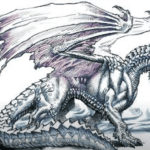Are you looking for a fantastic CR 2 creature that is rarely used? The Guard Drake is an amazing DnD Monster for beginning players to fight during their campaign. In this article, we will teach you everything there is to know about these medium dragons and how to fight them. Of course, if you are a DM, you will get plenty of tips in this to write up to help you get the most out of Guard Drakes in 5e.
Guard Drakes Stats and Actions
Stats
- Size: Medium Dragon
- Armor Class: 14 (natural armor)
- Hit Points: 52 (7d8 +21)
- Speed: 30 feet
Ability stats
| STR | DEX | CON | INT | WIS | CHA |
| 16 (+3) | 11 (+0) | 16 (+3) | 4 (-3) | 10 (+0) | 7 (-2) |
As you can see, this monster has a ton of STR and CON to work with. However, it also has two glaring weaknesses. The INT stat of the beast is very low, and the CHA is also not all that good.
Treats
- Skills: +2 perception
- Senses: Darkvision for 60 feet and passive perception 12
- Languages: Only understands Draconic but can not speak the language
- Challenge: 2, 450 experience
Actions
The Guard Drake has a couple of actions you should remember while fighting it. These are not too strong, but you never know when they will surprise you.
- Bite: the melee weapon attack is a +5 to hit and has a reach of 5 feet. The bit only hits one target and will hit for 7 (1 d8 +3) piercing damage.
- Tail: The attack with the tail is another Weapon Attack with a +5 hit and a reach of 5 feet. This attack hits one target and does a six-hit (1d6 + 3) bludgeoning damage.
- Multiattack: The Drake makes a multi-attack, one bite and one attack with the tail.
As you see, there is not a lot of danger or crazy mechanics coming from a guard drake in 5e. They aren’t very dangerous for a CR 2, but make sure your frontliners don’t underestimate them and send them to under-leveled players.

How to best use a Guard Drake 5e
1. Give your high-level players or NPC a Guard Drake Pet
A very common request from players is if they can have a Guard Drake as a pet. Be careful, as they are pretty strong monsters to give to lower-level players. There also is the fact that they are still wild creatures with very low intelligence. So they won’t act like a cute house cat that always loves you.
There is another problem with having a Guard Drake 5e pet. They are bonded for life to the first creatures they see when they hatch. While that does not mean they are automatically aggressive to everyone and anything else, they will always pick that creature above anyone or anything that came later into their lives.
Tip: Check out our article on Pseudodragon familiars.
2. A cool story hook for a quest about dragons
Guard Drakes are some of the weakest dragons around. They are perfect if you want to introduce a dragon storyline to your players early on. It would not be out of the question that there are Dragons who hate all those who slay or domesticate weaker dragons. Thus if your party kills or domesticates a Guard Drake, they might invoke the wrath of a sentient elder dragon who sends minions their way to punish these adventurers.
3. Guarding ruins and treasure
As the name implies, the Guard Dragon is used as a guardian for places and has enough intelligence to be used as a kind of watchdog. Since they are fiercely loyal to the first creature, they see and can be trained rather easily to follow commands. Moreover, these creatures are territorial and have excellent vision.
They are fantastic if your villains have the budget and the manpower to employ these creatures. Thanks to the fact that there are different variants, you can make guard groups that cover a wide array of damage types to make it harder to defeat them.
4. Hunting down the Cult of the Dragon
The Guard Drake is closely related to the Cult of the Dragon, which extensively used these creatures. They created these in a ritual and used them as guardians or combatants.
So if you want to introduce an awesome cult in your story, having your players abduct a pet Guard Drake by accident might be a great way to do so.
Ps: many cults used these beasts, so you don’t have to pick the Cult of the Dragon.
Chromatic Guard drakes and what they do
- Black Guard Drakes: These are amphibious, resistant to acid damage, and have a swimming speed of 30 feet.
- White Guard Drakes: These can burrow 20 feet like an ice elemental and have a climbing speed of 30 feet. These have a resistance to cold damage.
- Red Guard Drakes: These have a climbing speed of 30 feet and are resistant to fire damage.
- Green Guard Drakes: Greed drakes are amphibious and can swim 30 feet per turn. They are also immune to poison e.g. poison spray.
- Blue Guard Drakes: These have a resistance to lightning damage e.g. chain of lightning and a speed of 20 feet.

Guard Drakes creations
A ritual creates the Guard Drake. For this, an original dragon will need to have 10 lb of scales given freely. The dragon can choose to give the scales to an ally or a servant to sell them or create them themselves.
Next to the scales, you will also need fresh meat and an iron cauldron. Finally, the color of the scales will determine the speed, abilities, and resistances of the drake (see chapter above).
After a couple of days, there will be an egg in the cauldron, which will be in just a few hours. Whoever feeds the Guard Drake first will become its master. Then, in just three weeks, these drakes reach full maturity.
Final advice and tips
Guard Drakes in 5e DnD are not very strong but can be quite a menace in groups if they have the right resistance. However, thanks to the fact that rituals create them, a bigger story is almost always going on when you fight one. They can be sent by a mad wizard, a cult, or created by elder dragons themselves.
| Best Use | |
| 1. Give high-level players or NPCs a Guard Drake as a pet | |
| 2. Use as a story hook for a quest about dragons | |
| 3. Guarding ruins and treasure | |
| 4. Hunting down the Cult of the Dragon | |
| Chromatic Guard Drakes | |
| Black Guard Drakes | Amphibious, resistant to acid damage, swim speed 30 ft. |
| White Guard Drakes | Burrow 20 ft., climbing speed 30 ft., resistant to cold damage |
| Red Guard Drakes | Climbing speed 30 ft., resistant to fire damage |
| Green Guard Drakes | Amphibious, swim speed 30 ft., immune to poison damage |
| Blue Guard Drakes | Resistant to lightning damage, speed 20 ft. |
These creatures look uninspired at first glance, but a good DM can use them to set up a few story hooks at the beginning of a campaign. Check out these guides that might help you on your adventure:
Guard Drake 5e FAQ
Can you have a Guard Drake as a companion?
Yes, you can. However, the best way to have one is by hatching the egg and feeding it in the first person. You don’t need to do the ritual; buying a Guard Drake egg and being there for the baby drake is more than enough. However, you can also adopt an adult one, but these will never be as loyal.
What is the challenge rating of a Guard Drake?
Despite their low stats and abilities, these have a challenge rating of 2. All variants, red, green, white, blue, and black Guard drakes, all have the same CR. However, they do have different resistances.
